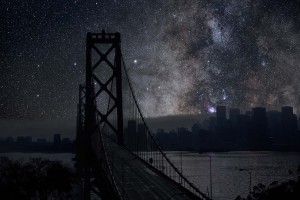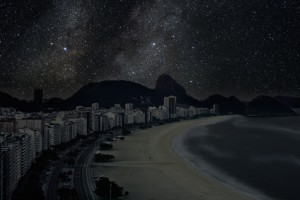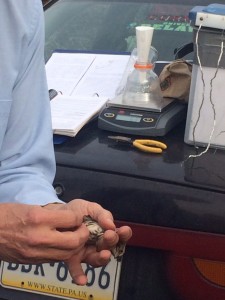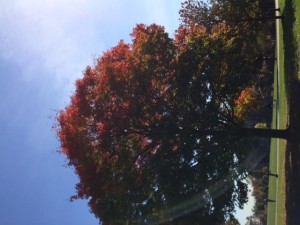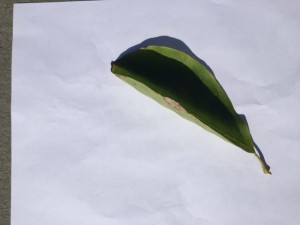Our discussion of the night sky in class today made me think of a photography exhibit from Thierry Cohen that a friend showed me last year. It is a photo series that imagines cities from around the world without any streetlights, under the night sky. The artist visited nine cities and took photos of them during the day. He then visited spots on the same longitude that had little to no light pollution and took photos of the night sky. For instance, the skies above Shanghai are actually in Western Sahara and Paris is illuminated by the stars over Montana at locations on the same longitude. Here are a few of the striking images, let me know what you think!
Author Archives: Erik Better
Inspiring Bird Banding
As Jeremy mentioned in class today, last week in conservation biology for lab we went to Jacobsburg state park and witnessed bird banding. The activity was very interesting and surprisingly simple. Brad, the man running the lab, set up 3 special nets for catching birds and then we waited. Over the course of 3 hours, 6 birds were caught, examined, banded, and released. The process itself and the Brad knowledge about the birds was interesting, but what truly impacted me about the lab was the amount of time and effort Brad spent birdbanding in his normal life. He had a full time job working in the easton area but also spent time every weekend banding birds. Brad found something he was passionate about and has devoted time, money, and energy into that passion. If more passion can be generated about nature maybe more will follow in Brad’s footsteps. 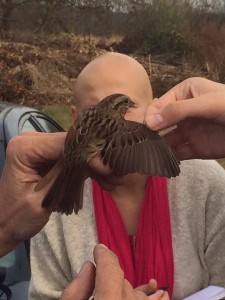
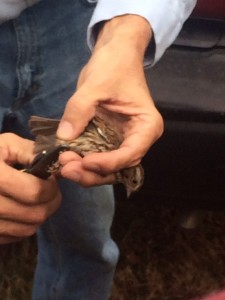
Passages
“Gathered on their favorite dead tree, heads nodding together, the vultures resembled from our vantage point a convocation of bald, politic funeral directors discussing business prospects always good. Dependable. (Abbey 52)”
Until this point Abbey had always portrayed the vultures as very elegant creatures. It is interesting that he still talks about them in an admiring way when discussing their searching for dead animals to eat, a topic that others may find unappealing and may not want to think about.
Tulips had cast their leaves on my path, flat and bright as doubloons. I passed under a sugar maple that stunned me by its elegant unself-consciousness: it was as if a man on fire were to continue calmly sipping tea. (Dillard 249).
Dillard’s imagery here is capturing, I can imagine myself walking through the woods.
Passages of Interest
“They never consulted with books, and know and can tell much less than they have done. The things which they practice are said not yet to be known….His life passes deeper in nature than the studies of the naturalist penetrate; himself a subject for a naturalist. Such a man has some right to fish, and i love to see nature carried out in him” (Thoreau 307)
Thoreau seems to respect those who interact with nature on what he believes to be a truer level. The phrase “nature carried out in him” especially attracted me to this passage because it goes back to our views of nature and whether or not humans are part of nature. Thoreau is suggesting that by living the right way we become a citizen of nature rather than a disturbance to it.
“Has she been nine years growing, and now, when the great world for the first time puts out a hand to her, must she thrust it aside for a birds sake?” (Jewett, 1206).
This raises the issue of environmental justice for me. I empathize with sylvia and think it is an impossible decision for those who are impoverished to reject additional financial gains in order to protect the environment. This is why I believe true sustainability addresses both inequalities within our current generation as well as potential inequalities for future generations.
A New Appreciation
While I love hiking in general, I was not incredibly excited for our trip to the catskill mountains. It seemed kind of unnecessary to me to drive three and a half hours to go on a hike, and to spend more time in the car than actually hiking. It was true that on a normal saturday I would probably watch college football and do nothing productive, but being the college student who loves sleep that I am, I hated having to wake up at 6:15 in the morning to be ready to go. Plus, on top of all of those minor complaints, up to this point all of my favorite hikes I had been on in my life had been on the west coast. I found incredible beauty and awe in the hikes of the Sierra Nevada mountains thousands of feet above sea level with views for miles around. Yet, while my hiking experience on the East Coast was limited, none of the hikes I had been on had been anything comparable to hiking on the west coast.
When we finally arrived at the trailhead, I was in a much better mood. I had survived the early morning wake up and long car ride, and now got to do the thing that was actually enjoyable to me, hike. We started walking up the trail and immediately I was drawn to all of the leaves on the ground. I had experienced East Coast fall before and seen the leaves changing color, but I had never been among such variation of color and so many leaves all at once. They covered the trail making it slippery and wet, but with each additional step, and each additional leaf crackling under my feet I felt more and more of a connection with the area. While I was enjoying the hike and very glad my professors had forced me to stop be active on a saturday, the hike did not compete with some of the experiences I had hiking the Sierra Nevada mountains.
My opinion of the comparative beauty of the west and east coast all changed when we reached the first ledge. I have spent my whole college career comparing the east and west coast. Me and my friends have debated natural beauty, politics, sports, and a whole range of other topics with me always defending the west coast. Standing on that first ledge and looking out and rolling hills of autumn colors I was just as awestruck as I have been standing on the top of any mountain. The vista took my breath away like I never expected it to. It was at this moment that I decided to try and stop comparing at least the natural beauty on the east and west coast. While I will always have an affinity for west coast environments because I have grown up in them and am more familiar and comfortable in them, this hike taught me that the east coast can also be stunningly beautiful in its own way.
Nature Wars
“By mid-1990s, Michigan’s whitetail population had exploded in the southern third of the state, where millions of acres of cleared cropland had gone out of production, grown up with trees, and been converted to deer friendly sprawl.”(104)
Sterba spends a major portion of this book discussing the species such as the whitetail deer and beaver that have returned as farmland becomes forest. What he does not address is that certain species such as the deer have thrived because they are tolerant of living on the edge of human development in these fragmented forests. As we have learned in my conservation biology class, most species are unlike the deer and do not do well in fragmented forests that come in contact with humans. These edge sensitive species are not likely to do well in any of these regrowth forests surrounded by humans and the ecosystems will not have much biodiversity, simply the few species that thrive on the edge.
“As people left the land, pines and birches and blackberries crowded into the neglected pastures and forests sprang up in old corn fields. Many of the homes, barns, schoolhouses, and wooden fences collapsed, leaving only their more durable remnants in woods that are now crisscrossed with trails descended from an abandoned network of rural roads” (44)
Extremely powerful imagery.
“Although the environmental damage was great, the words environment and ecology were not familiar at the time and weren’t a big concern. Far more important was the scary idea that the population might run out of trees”(31)
“Hideous and desolate wilderness, full of wilde beasts and wilde men” (19)
It is very interesting seeing how the collective mindset has shifted and changed over time.
Campus of Trees
What struck me most about walking around campus while paying specific attention to the trees was how oblivious I am. I had been told that lafayette had a ton of rare and different trees across its campus. Despite knowing this, I realized that I have never really paid attention to the trees while I have walked around. While I had noticed they were different shapes and sizes, I had never taken the time to truly appreciate the variety and different types of beauty. When I walked around yesterday afternoon I was struck by how beautiful some of the trees are, and hope to continue to notice them as I walk around campus.
Joey ritter and I walked from acopian to farinon and then around behind Pardee. While we looked at many trees and tried to determine what they were from the pamphlet, we paid extra attention to three of them and tried to determine what they were from both the guide and from leafsnap.
The first tree that really caught my eye was this one on the edge of the quad. What was interesting to me was that the tops of the leaves and the ones that seemed to be exposed to more sunlight were far redder than the average leaf.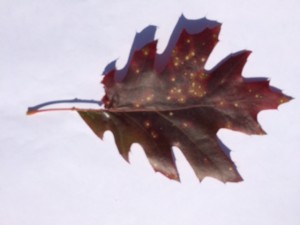
We tried to put this leaf into leafsnap to determine the tree but got no results. It seemed to be a maple potentially.
The third tree we attempted to put into leafsnap came up with a few results, but we were unable to determine which was correct. It listed White Ash, Corkscrew Willow, and English Elm as all possibilities for this leaf.
Passages from Readings
“Unfortunately, because we have been so slow to recognize the unprecedented importance of suburban gardens for the preservation of wildlife, gardners across the nation have been caught off guard. We have proceeeded with garden design as we always have, with no knowledge of the new role our gardens play, and , alas, it shows. All too often the first step in the suburbanization of an area is to bulldoze the plant assemblages native to our neighborhoods and then to replace them with large manicured lawns.”
“It is increasingly clear that much of our wildlife will not be able to survive unless food, shelter, and nest sites can be found in suburban habitats”
Thoreau: Pond Scum
I stumbled upon this very interesting article published a few days ago about Thoreau. While, I don’t agree with many of the authors points, it is interesting viewing Thoreau in the opposite light from which we have been discussing him for the past semester. Below are a few of the most interesting quotes I found, but the whole article is worth reading. Let me know if you think the author has any valid points.
“The real Thoreau was, in the fullest sense of the word, self-obsessed: narcissistic, fanatical about self-control, adamant that he required nothing beyond himself to understand and thrive in the world.”
“But “Walden” is less a cornerstone work of environmental literature than the original cabin porn: a fantasy about rustic life divorced from the reality of living in the woods, and, especially, a fantasy about escaping the entanglements and responsibilities of living among other people.”
“Like his fellow-transcendentalists, he was suspicious of tradition and institutions, and regarded personal intuition and direct revelation as superior foundations for both spiritual and secular beliefs. Unlike his fellow-transcendentalists, he also regarded his own particular intuitions and revelations as superior to those of other people.”
http://www.newyorker.com/magazine/2015/10/19/pond-scum
Recycling
Over the weekend my uncle, knowing I’m an environmental studies major, brought up an article he had recently read in the New York Times about recycling. The article had been talked about in my environmental studies capstone class, but being environmental studies majors most of us had the same opinion: Even if all of the trash generated by americans for the next 1000 years can fit on one-tenth of 1 percent of the land available for grazing, we should still recycle because the ability to hide this trash doesn’t mean we shouldn’t worry about how much we have created and work towards reducing that amount. Even if some recycling is not nearly as productive as other kinds, and even if you’d have to recycle roughly 40,000 plastic bottles to offset the greenhouse effect of flying round trip between New York and London, even those minimal gains make recycling worth the effort.
It was actually really refreshing to hear another perspective on the story. While I did not agree with my uncle, he felt this article spoke to him and articulated the ways he had felt about recycling for a long time. That only the economically beneficial products should be recycled because the rest was a waste of effort for very little gain.
I have posted the article below, let me know what you think.:
http://www.nytimes.com/2015/10/04/opinion/sunday/the-reign-of-recycling.html?_r=0


